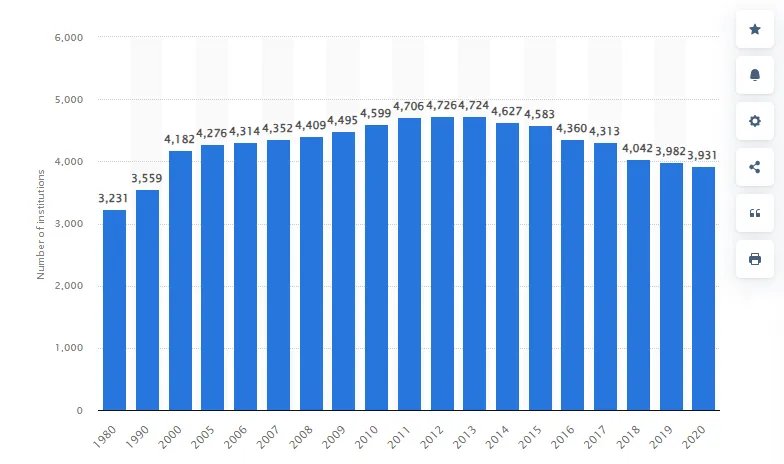We had the retail apocalypse. This was something that became known in the mid-2010s.
Right now, we are watching Hollywood implode before our eyes as technological disruption has already offered more competition. Things are going to get interesting when we see the next phase where content creation is completely changed.
In a quest to stay on top of things, I am constantly seeking where the next disruption could take place. What is going to see a technological change in a massive way.
We have one although it isn't only technology.
Upper Level Education In The US Is Cooked
In the United States, there is great debate about the state of the university system. There are a ton of things wrong with the present situation, one key being the government is in the middle of it all.
That said, this is not a story exclusively about technology. There is another factor.
Before getting into that, please bear in mind I am not calling for this to happen now. We are looking into the future to see where things could be in 10-15 years. That means the onset could still be a few years away.
Here is a headline from CNBC:
A private arts college is set to close, citing issues with the new FAFSA. Others may follow, expert warns
Certainly, the Delaware College of art and Design and its 129 students isn't indicative of an apocalypse starting. It does, however, provide a bit of insight into what is taking place.
The article mention about changing in funding. Realistically, this is a problem of demographics.
If we look at the United States demographic tree, this is what we see.

Source: Wikipedia
Notice what happens around the line near the 20 on the left hand side and move down towards zero. Both sides see a massive contraction.
This is where we can see major issues forming. There are simply fewer children in the United States who will be entering university over the next 20 years. This is a situation echoed throughout most of the developed world.
Here is a chart of the latest actual numbers (through 2021):

In 2010, there were 18 million people enrolled in the university system. As of 2021, that number fell to 15.4 million. That is a loss of 2.6 million people or 14.4%.
According to the demographic tree, the fun is just getting started.
The Future
So what is the future going to look like?
Here is where some factors come into play.
One of the big issues is the decline in men attending these schools. Men accounts for just over 40% while women were a tad under 60%. Much of the decline (70%) over the previous 5 years came from men.
This is bringing about an interesting situation. Why is this happening and can it be reversed?
The why is difficult to pinpoint but the reversal is clear: the answer is no. The future of college campuses is going to be less men. While some degrees will be required, with the advancement of artificial intelligence starting to wage havoc in the job market, men are going to avoid it.
Another potentiality is that online education starts to take over. We will see this being slow due to the fact we are dealing with a regulated environment. However, due to the rising costs, people are going to seek out less expensive solutions.
Finally, men are moving more into the trades. With all the talk of AI, it appears that blue collar is actually less susceptible, at least for the moment. White collar jobs are the ones likely to get whacked first. Here is where the upper education people are going to get hurt.
Even if the system was successful in drawing men back into the fold, it will take a number of years to do that. As we move towards the end of the decade, online education is going to be much bigger. That will be arriving right around the time of the population contraction among high school graduates.
The situation received more bad news today:
U.S. Births fell last year, resuming a long national slide.
A little under 3.6 million babies were born in 2023, according to provisional statistics released Thursday by the Centers for Disease Control and Prevention. That’s about 76,000 fewer than the year before and the lowest one-year tally since 1979.
It seems like the previous trend is starting again.
Worthless Degrees
One of the major issues we are seeing is that universities are passing out a ton of worthless degrees. Due to the disconnect with the real world, they are graduating students with certificates that are useless in the business world.
While it might be an interesting topic to study, the reality is becoming clear that having a degree in ancient Irish poetry is not going to do much for you. Of course, the $50K, $100K, or $200K in student loans doesn't help either.
Many have questioned the approach these universities are taking. Now people are starting to realize that the road to wealth often does not include college. In fact, that might be a path to lifelong financial slavery.
There will still be a need for doctors, lawyers, and other degrees of specialized training. The reality is these often require additional schooling on top of the four years.
Outside of that, much of what is being offered is trash. Even business degrees have little value in the marketplace. companies have been burned hiring those with MBA, people you would think know business. Sadly, these are the ones who get elevated, putting someone from finance in charge of an engineering or manufacturing company.
It looks like some of this is starting to have an impact. The fun is just getting started. These are the number of colleges and universities in the United States according to Statista:

This is something that might see acceleration throughout the rest of the decade.
An upper level education apocalypse might be in the cards. Keep an eye out.